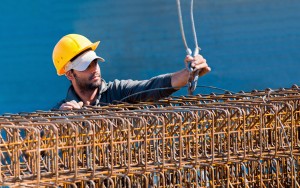Picture this if you will; you are sitting in the cab of a huge crane, towering over a large construction site hundreds of feet below. Your job is to maneuver the crane’s hook along the jib to an exact location in order to lift cargo weighing as much as twenty tons…sometimes more. Once the hook is in place, you must drop it to the right spot, and wait for the rigger below to attach the heavy cargo to your hook. Your only communication with that rigger is by hand signals and radio. This means that you are depending on seeing the signals from a man standing hundreds of feet below you, or feed from a radio with static, wind, and interference often breaking up the communication. If this is not enough pressure, you also have the knowledge that one small mistake could cost thousands, or even millions of dollars in equipment, and even loss of lives.
Until recently, the lives of the workers on the job site below, the equipment, machinery, and the cargo were all dependent on hand signals and radio chats for their safety. This was the only way that the operator could learn when the cargo was loaded, if the cargo was secured, and when it was time to make the lift. Needless to say, it was very slow going. One lift could take a great deal of time, since the crane operator would make the lift until he was sure that every aspect of it was right. Doing so by hand signals and radio waves could be quite time-consuming, and the more time it took to carry out one lift, the less productive the day would be. Often, crane operators may have felt pressured to pick up the pace, which could have lead to accidents, property loss, and even deaths. Although slowing down may have prevented this, it also lessened productivity.
Fortunately, HoistCam saw this problem and offers a brilliant solution. By placing cameras on cranes, the crane operator can now see every step of the lift, from start to finish. Blind spots are eliminated, and the crane operator is able to retain control of the load, responding immediately to any problems. These cameras can be placed anywhere that the crane operator needs them to be, giving him line of sight to the load at all times. The crane operator can see the rigger, making communication much easier and accurate. There are no more blind spots, since the crane operator not only has a clear view of the rigger, but of the load as well. With blind spots eliminated, each lift will take much less time, and be much safer. With safer lifts, there will be less accidents, and less accidents mean less cost. The time that it takes for each blind lift can be reduced by as much as 39 percent, and for other lifts as much as 27 percent. Faster lifts of course, mean more lifts per day…and more lifts per day equals more productivity on the job site!


